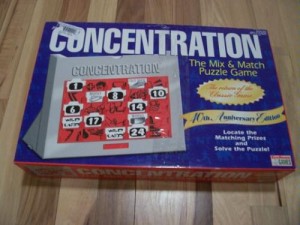Sorry I haven’t posted in a while. I’ve been busy thinking deep thoughts…
The Concentration Board Game
Back in the early days of game shows, there were tons of strange ideas about what kind of games people would want to play. Any sort of game that gave the audience the possibility of walking away with some interesting prizes and money, meant that people would flock to it. One of those games was Concentration, and it has stuck around in various incarnations since 1958.

Anything that was of interest on television was also of interest to toy stores, so every show had at least one version of its board game, and Concentration wasn’t any different, spawning various versions up until just a year or two ago. The simple game of memory matching and puzzle deduction has had home game editions since the first year it was on television all the way up until present day. Concentration still exists as a board game, computer game, and mobile phone game.
The question remains though, is the 40th Anniversary Edition, as put out by Encore Games, worthy of the esteemed traditions of Concentration?
Concentration Rules
The basics of Concentration are as well known as the rules for Candyland. The game has two players pitted against each other to figure out some sort of rebus-style puzzle. If you aren’t familiar with a rebus, it is a visual puzzle that uses pictures to represent words or part of words. For example: A picture of a bird, minus D, plus a picture of an ice cream sundae, minus a picture of a sun could mean the word ‘Birthday’.
Other than just figuring out a word puzzle, the players go back and forth trying to match tiles that are covering the puzzle. It is this mix of trying to make matches on a grid of 25 tiles, ending in trying to figure out a word puzzle that has made Concentration such a classic. There are various prizes under each of the tiles, and also the ‘TAKE A PRIZE’ and ‘WILD CARD’ tiles that add a little more punch to the game, but we’ll get more into those in just a moment.
The first real problem with the game is setting it up. The entire board and layout takes a bit of time to get together, each of the 25 tiles must be placed in the board, and the rebus puzzle must be laid into the board holder. Where this doesn’t sound too time consuming, it is the actual pieces that are the problem. Everything is made of cardboard, and in the world of games that you are going to be lugging to friends’ homes, jostling every time you are trying to get the game beneath it, and repeated play in one night, means that the game is going to show its wear and tear pretty quickly. Add in that this game has a feeling that it is geared towards younger kids, and it really will show its age.
Concentration Instructions
So you have everything laid out, and you are ready to play a game. Decide who is going to go first (youngest player, ladies go first, flip a coin) and let the game begin. As described above, you’re going to go back and forth picking tiles up, two at a time. If they match, you get an attempt to guess the puzzle. At first, you will probably pass on attempting to guess, as you are only going to see the odd corner of a shape or some white space.
If you made a match, go again. You continue to go until you miss a match, and then it is the next player’s turn. This goes back and forth, guessing, removing tiles, and collecting prizes until someone gets the answer right.
The next flaw in the game is that the minute someone guesses, they have to go look at the answer key. The game suggests that you might have a ‘Master of Ceremonies’ whose job it is to sit and tell you when you get the answer right, which is easily one of the worst jobs in board gaming history. You get to sit and watch, while two of your friends get to play a game. The only saving grace is if you have a friend that really likes to ham it up and pretend that you are on the game show. It is the perfect spot for a parent who wants to ‘play a game’ with their children.
Mixed on the board are wild card tiles as well as TAKE ONE tiles. Pulling a wild card tile means that you have made a match, no matter what the other tile is. If you happen to match the wild card tiles, then you get the luck of pulling two more tiles for a massive four card reveal. The ‘Take One’ cards allow you the ability to take a prize from your opponent. Did he just win the life-time supply of turtle wax? Oh, he did, but he doesn’t get to keep it. Playing the game, we found this tile to be best just to protect your own winnings. It becomes sort of a Mexican stand-off of sorts. She takes the new dining room sit, he steals it back.
At the end of a round, the winner converts their prizes into game cash, and you play another round. Do this for three rounds or until you get bored, add up all of your cash, and the person with the most cash wins the game.
Concentration Strategy
I’d love to tell you that there are tons of strategies in this game, but in essence you are playing the children’s game of Memory, but with a weird word puzzle at the end. I say weird, because Endless Games didn’t really seem to move the rebus cards forward, and I guarantee they are the same as older versions of the game. This means that you are going to be staring with your opponent pondering loudly, ‘Is that an awl or a screwdriver? Oh wait, maybe it just means tool?’
Sadly, this version of Concentration is not aging well at all, and as we move forward there are tons of amusing ways they could push the ideas forward, but the game itself seems stuck in its era.
There are a couple of ways you can spice up this game, but they are only for the grown-ups reading this. The first is the drinking game variant, where after the first round you can pay to have your opponent take a shot. (We set the cost of a shot at $500 to insure that we would avoid massive hangovers the next day) Then the party watched as the two players became very interested in the game, due to not wanting to get too drunk.
The next is a more adult variant, where you remove the ‘hundreds’ from the game and play for real money, or turn the prizes into truth or dares. There is a lot you can do with this game given a little creativity. The reality is that the game just doesn’t truly stand on its own, like so many of its contemporaries. It’s suffering from age, and the quality of the packaging leaves quite a bit to be desired, so anything you can do to spruce it up will help you get a return on the money you spent on it.
If you are a lover of nostalgia and rebus puzzles, then this is completely right for you, but otherwise you might find that you throw it in your closet and forget about it. Try it with a few variations amongst your more party oriented friends, and you will find a game that is a lot more fun than the rules give you.




